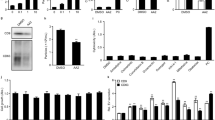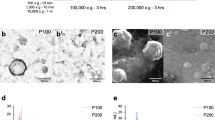Abstract
Extracellular vesicles (EVs) are important carriers for biomolecules in the microenvironment that greatly promote intercellular and extracellular communications. However, it is unclear whether bombesin receptor-subtype 3 (BRS-3), an orphan G-protein coupled receptor, can be packed into EVs and functionally transferred to recipient cells. In this study, we applied the synthetic agonist and antagonist to activate and inhibit the BRS-3 in HEK293-BRS-3 cells, whose EVs release was BRS-3 activation dependent. The presence of BRS-3 in harvested EVs was further confirmed by an enhanced green fluorescent protein tag. After recipient cells were co-cultured with these EVs, the presence of BRS-3 in the recipient cells was discovered, whose function was experimentally validated. Quantitative proteomics approach was utilized to decipher the proteome of the EVs derived from HEK293-BRS-3 cells after different stimulations. More than 900 proteins were identified, including 51 systematically dysregulated EVs proteins. The Ingenuity Pathway Analysis (IPA) revealed that RhoA signaling pathway was as an essential player for the secretion of EVs. Selective inhibition of RhoA signaling pathway after BRS-3 activation dramatically reversed the increased secretion of EVs. Our data, collectively, demonstrated that EVs contributed to the transfer of functional BRS-3 to the recipient cells, whose secretion was partially regulated by RhoA signaling pathway.





Similar content being viewed by others
Data availability
The mass spectrometry proteomics data and the search data by MaxQuant (version 1.6.1.0) have been deposited to the ProteomeXchange Consortium (http://www.ebi.ac.uk/pride/archive/) via the PRIDE partner repository with the dataset identifier PXD027980.
Code availability
Not applicable.
References
van Niel G, D’Angelo G, Raposo G (2018) Shedding light on the cell biology of extracellular vesicles. Nat Rev Mol Cell Biol 19:213–228. https://doi.org/10.1038/nrm.2017.125
Théry C, Witwer KW, Aikawa E, Alcaraz MJ, Anderson JD et al (2018) Minimal information for studies of extracellular vesicles 2018 (MISEV2018): a position statement of the International Society for Extracellular Vesicles and update of the MISEV2014 guidelines. J Extracell Vesicles 7:1535750. https://doi.org/10.1080/20013078.2018.1535750
Yáñez-Mó M, Siljander PR, Andreu Z, Zavec AB, Borràs FE et al (2015) Biological properties of extracellular vesicles and their physiological functions. J Extracell Vesicles 4:27066. https://doi.org/10.3402/jev.v4.27066
Raposo G, Stoorvogel W (2013) Extracellular vesicles: exosomes, microvesicles, and friends. J Cell Biol 200:373–383. https://doi.org/10.1083/jcb.201211138
Wolf P (1967) The nature and significance of platelet products in human plasma. Br J Haematol 13:269–288. https://doi.org/10.1111/j.1365-2141.1967.tb08741.x
Tkach M, Théry C (2016) Communication by extracellular vesicles: where we are and where we need to go. Cell 164:1226–1232. https://doi.org/10.1016/j.cell.2016.01.043
Wu P, Zhang B, Ocansey DKW, Xu W, Qian H (2021) Extracellular vesicles: a bright star of nanomedicine. Biomaterials 269:120467. https://doi.org/10.1016/j.biomaterials.2020.120467
Abhange K, Makler A, Wen Y, Ramnauth N, Mao W et al (2021) Small extracellular vesicles in cancer. Bioact Mater 6:3705–3743. https://doi.org/10.1016/j.bioactmat.2021.03.015
Pocsfalvi G, Stanly C, Vilasi A, Fiume I, Capasso G et al (2016) Mass spectrometry of extracellular vesicles. Mass Spectrom Rev 35:3–21. https://doi.org/10.1002/mas.21457
Isola AL, Chen S (2016) Exosomes: the link between GPCR activation and metastatic potential? Front Genet. https://doi.org/10.3389/fgene.2016.00056
Rosenbaum DM, Rasmussen SG, Kobilka BK (2009) The structure and function of G-protein-coupled receptors. Nature 459:356–363. https://doi.org/10.1038/nature08144
Hauser AS, Attwood MM, Rask-Andersen M, Schiöth HB, Gloriam DE (2017) Trends in GPCR drug discovery: new agents, targets and indications. Nat Rev Drug Discov 16:829–842. https://doi.org/10.1038/nrd.2017.178
Morri M, Sanchez-Romero I, Tichy AM, Kainrath S, Gerrard EJ et al (2018) Optical functionalization of human Class A orphan G-protein-coupled receptors. Nat Commun 9:1950. https://doi.org/10.1038/s41467-018-04342-1
Xiao C, Reitman ML (2016) Bombesin-like receptor 3: physiology of a functional orphan. Trends Endocrinol Metab 27:603–605. https://doi.org/10.1016/j.tem.2016.03.003
Fathi Z, Corjay MH, Shapira H, Wada E, Benya R et al (1993) BRS-3: a novel bombesin receptor subtype selectively expressed in testis and lung carcinoma cells. J Biol Chem 268:5979–5984
Jensen RT, Battey JF, Spindel ER, Benya RV (2008) International Union of Pharmacology. LXVIII. Mammalian bombesin receptors: nomenclature, distribution, pharmacology, signaling, and functions in normal and disease states. Pharmacol Rev 60:1–42. https://doi.org/10.1124/pr.107.07108
Weber HC (2009) Regulation and signaling of human bombesin receptors and their biological effects. Curr Opin Endocrinol Diabetes Obes 16:66–71. https://doi.org/10.1097/med.0b013e32831cf5aa
Piñol RA, Zahler SH, Li C, Saha A, Tan BK et al (2018) Brs3 neurons in the mouse dorsomedial hypothalamus regulate body temperature, energy expenditure, and heart rate, but not food intake. Nat Neurosci 21:1530–1540. https://doi.org/10.1038/s41593-018-0249-3
Li M, Liang P, Liu D, Yuan F, Chen GC et al (2019) Bombesin receptor subtype-3 in human diseases. Arch Med Res 50:463–467. https://doi.org/10.1016/j.arcmed.2019.11.004
Ramos-Alvarez I, Lee L, Mantey SA, Jensen RT (2019) Development and characterization of a novel, high-affinity, specific, radiolabeled ligand for BRS-3 receptors. J Pharmacol Exp Ther 369:454–465. https://doi.org/10.1124/jpet.118.255141
von Zastrow M (2003) Mechanisms regulating membrane trafficking of G protein-coupled receptors in the endocytic pathway. Life Sci 74:217–224. https://doi.org/10.1016/j.lfs.2003.09.008
Sorkin A, Von Zastrow M (2002) Signal transduction and endocytosis: close encounters of many kinds. Nat Rev Mol Cell Biol 3:600–614. https://doi.org/10.1038/nrm883
Dores MR, Trejo J (2019) Endo-lysosomal sorting of G-protein-coupled receptors by ubiquitin: diverse pathways for G-protein-coupled receptor destruction and beyond. Traffic 20:101–109. https://doi.org/10.1111/tra.12619
Pironti G, Strachan RT, Abraham D, Mon-Wei Yu S, Chen M et al (2015) Circulating exosomes induced by cardiac pressure overload contain functional angiotensin II type 1 receptors. Circulation 131:2120–2130. https://doi.org/10.1161/circulationaha.115.015687
Dong L, Zhang B, Wu L, Shang Z, Liu S et al (2020) Proteomics analysis of cellular BRS3 receptor activation reveals potential mechanism for signal transduction and cell proliferation. J Proteome Res 19:1513–1521. https://doi.org/10.1021/acs.jproteome.9b00760
Qiao Z, Zhang Y, Ge M, Liu S, Jiang X et al (2019) Cancer cell derived small extracellular vesicles contribute to recipient cell metastasis through promoting HGF/c-met pathway. Mol Cell Proteomics 18:1619–1629. https://doi.org/10.1074/mcp.RA119.001502
Sun Y, Liu S, Qiao Z, Shang Z, Xia Z et al (2017) Systematic comparison of exosomal proteomes from human saliva and serum for the detection of lung cancer. Anal Chim Acta 982:84–95. https://doi.org/10.1016/j.aca.2017.06.005
Guan XM, Chen H, Dobbelaar PH, Dong Y, Fong TM et al (2010) Regulation of energy homeostasis by bombesin receptor subtype-3: selective receptor agonists for the treatment of obesity. Cell Metab 11:101–112. https://doi.org/10.1016/j.cmet.2009.12.008
Moreno P, Mantey SA, Nuche-Berenguer B, Reitman ML, González N et al (2013) Comparative pharmacology of bombesin receptor subtype-3, nonpeptide agonist MK-5046, a universal peptide agonist, and peptide antagonist Bantag-1 for human bombesin receptors. J Pharmacol Exp Ther 347:100–116. https://doi.org/10.1124/jpet.113.206896
Almasabi S, Ahmed AU, Boyd R, Williams BRG (2021) A potential role for integrin-linked kinase in colorectal cancer growth and progression via regulating senescence and immunity. Front Genet 12:638558. https://doi.org/10.3389/fgene.2021.638558
Chen H, Liu X, Chen H, Cao J, Zhang L et al (2014) Role of SIRT1 and AMPK in mesenchymal stem cells differentiation. Ageing Res Rev 13:55–64. https://doi.org/10.1016/j.arr.2013.12.002
Bebelman MP, Crudden C, Pegtel DM, Smit MJ (2020) The convergence of extracellular vesicle and GPCR biology. Trends Pharmacol Sci 41:627–640. https://doi.org/10.1016/j.tips.2020.07.001
Sedgwick AE, Clancy JW, Olivia Balmert M, D’Souza-Schorey C (2015) Extracellular microvesicles and invadopodia mediate non-overlapping modes of tumor cell invasion. Sci Rep 5:14748. https://doi.org/10.1038/srep14748
Pierce KL, Premont RT, Lefkowitz RJ (2002) Seven-transmembrane receptors. Nat Rev Mol Cell Biol 3:639–650. https://doi.org/10.1038/nrm908
González N, Martín-Duce A, Martínez-Arrieta F, Moreno-Villegas Z, Portal-Núñez S et al (2015) Effect of bombesin receptor subtype-3 and its synthetic agonist on signaling, glucose transport and metabolism in myocytes from patients with obesity and type 2 diabetes. Int J Mol Med 35:925–931. https://doi.org/10.3892/ijmm.2015.2090
Moreno P, Mantey SA, Lee SH, Ramos-Álvarez I, Moody TW et al (2018) A possible new target in lung-cancer cells: The orphan receptor, bombesin receptor subtype-3. Peptides 101:213–226. https://doi.org/10.1016/j.peptides.2018.01.016
Li M, Lu Y, Xu Y, Wang J, Zhang C et al (2018) Horizontal transfer of exosomal CXCR4 promotes murine hepatocarcinoma cell migration, invasion and lymphangiogenesis. Gene 676:101–109. https://doi.org/10.1016/j.gene.2018.07.018
Moreno P, Ramos-Álvarez I, Moody TW, Jensen RT (2016) Bombesin related peptides/receptors and their promising therapeutic roles in cancer imaging, targeting and treatment. Expert Opin Ther Targets 20:1055–1073. https://doi.org/10.1517/14728222.2016.1164694
Feng Y, Guan XM, Li J, Metzger JM, Zhu Y et al (2011) Bombesin receptor subtype-3 (BRS-3) regulates glucose-stimulated insulin secretion in pancreatic islets across multiple species. Endocrinology 152:4106–4115. https://doi.org/10.1210/en.2011-1440
Ramos-Álvarez I, Martín-Duce A, Moreno-Villegas Z, Sanz R, Aparicio C et al (2013) Bombesin receptor subtype-3 (BRS-3), a novel candidate as therapeutic molecular target in obesity and diabetes. Mol Cell Endocrinol 367:109–115. https://doi.org/10.1016/j.mce.2012.12.025
González N, Moreno P, Jensen RT (2015) Bombesin receptor subtype 3 as a potential target for obesity and diabetes. Expert Opin Ther Targets 19:1153–1170. https://doi.org/10.1517/14728222.2015.1056154
Marcoux G, Laroche A, Hasse S, Bellio M, Mbarik M et al (2021) Platelet EVs contain an active proteasome involved in protein processing for antigen presentation via MHC-I molecules. Blood. https://doi.org/10.1182/blood.2020009957
Wu CH, Silvers CR, Messing EM, Lee YF (2019) Bladder cancer extracellular vesicles drive tumorigenesis by inducing the unfolded protein response in endoplasmic reticulum of nonmalignant cells. J Biol Chem 294:3207–3218. https://doi.org/10.1074/jbc.RA118.006682
Alfadda AA, Benabdelkamel H, Masood A, Moustafa A, Sallam R et al (2013) Proteomic analysis of mature adipocytes from obese patients in relation to aging. Exp Gerontol 48:1196–1203. https://doi.org/10.1016/j.exger.2013.07.008
Young LC, Hartig N, Boned Del Río I, Sari S, Ringham-Terry B et al (2018) SHOC2-MRAS-PP1 complex positively regulates RAF activity and contributes to Noonan syndrome pathogenesis. Proc Natl Acad Sci USA 115:10576–10585. https://doi.org/10.1073/pnas.1720352115
Wang Q, Symes AJ, Kane CA, Freeman A, Nariculam J et al (2010) A novel role for Wnt/Ca2+ signaling in actin cytoskeleton remodeling and cell motility in prostate cancer. PLoS ONE 5:126–126
Yu OM, Brown JH (2015) GPCR and RhoA-stimulated transcriptional responses mediating inflammation. Differen Cell Prolif Mol Pharmacol 88(1):171–180. https://doi.org/10.1124/mol.115.097857
Pang MF, Stallings-Mann M, Siedlik MJ, Han S, Nelson CM (2016) ILK as a signaling nexus for induction of breast cancer stem cells in response to tissue stiffness and hypoxia. Eur J Cancer 61:S40–S40
Glebov K, Löchner M, Jabs R, Lau T, Merkel O et al (2015) Serotonin stimulates secretion of exosomes from microglia cells. Glia 63:626–634. https://doi.org/10.1002/glia.22772
Islam A, Jones H, Hiroi T, Lam J, Zhang J et al (2008) cAMP-dependent protein kinase A (PKA) signaling induces TNFR1 exosome-like vesicle release via anchoring of PKA regulatory subunit RIIbeta to BIG2. J Biol Chem 283:25364–25371. https://doi.org/10.1074/jbc.M804966200
Gan L, Seki A, Shen K, Iyer H, Han K et al (2019) The lysosomal GPCR-like protein GPR137B regulates Rag and mTORC1 localization and activity. Nat Cell Biol 21:614–626. https://doi.org/10.1038/s41556-019-0321-6
Kajimoto T, Mohamed NNI, Badawy SMM, Matovelo SA, Hirase M et al (2018) Involvement of Gβγ subunits of G(i) protein coupled with S1P receptor on multivesicular endosomes in F-actin formation and cargo sorting into exosomes. J Biol Chem 293:245–253. https://doi.org/10.1074/jbc.M117.808733
Das K, Prasad R, Singh A, Bhattacharya A, Roy A et al (2018) Protease-activated receptor 2 promotes actomyosin dependent transforming microvesicles generation from human breast cancer. Mol Carcinog 57:1707–1722. https://doi.org/10.1002/mc.22891
Funding
This work was supported by grants from the Natural Science Foundation of Shanghai (No. 21ZR1433200, No. 19ZR1427800), the National Key Research and Development Program of China (No. 2017YFC1200204), the National Natural Science Foundation of China (No. 21675110), and the Key Scientific Project of Shanghai Jiao Tong University (No. TMSK-2020–130, No. YG2017MS80).
Author information
Authors and Affiliations
Contributions
ZYW, LHW, and HYW performed the experiments and analyzed the data. YZ and HX directed the project and wrote the manuscript. All authors read and approved the final manuscript.
Corresponding authors
Ethics declarations
Conflict of interest
The authors declare no competing financial interests.
Additional information
Publisher's Note
Springer Nature remains neutral with regard to jurisdictional claims in published maps and institutional affiliations.
Supplementary Information
Below is the link to the electronic supplementary material.
Rights and permissions
About this article
Cite this article
Wang, Z., Wu, L., Wang, H. et al. Agonist-induced extracellular vesicles contribute to the transfer of functional bombesin receptor-subtype 3 to recipient cells. Cell. Mol. Life Sci. 79, 72 (2022). https://doi.org/10.1007/s00018-021-04114-z
Received:
Revised:
Accepted:
Published:
DOI: https://doi.org/10.1007/s00018-021-04114-z




